SEO has always been an integral part of every digital marketing strategy.
61% of marketers say that improving SEO and growing their organic presence is their top inbound marketing priority.
However, optimizing websites with tens of thousands of web pages and keywords can be extremely difficult. That’s where enterprise SEO comes into the picture.
In this post, I’ll teach you all about enterprise SEO, provide you with some examples to help you understand it better, and discuss some enterprise SEO tools to take your SEO campaign to the next level.
Definition of Enterprise SEO
First of all, what do we mean by “enterprise SEO”?
Enterprise SEO can be defined as a set of search engine optimization strategies aimed at improving the organic presence of a large enterprise.
Businesses having thousands of pages on their websites require specialized SEO teams and high-level strategies to drive more traffic. Enterprise SEO teams offer actionable advice that helps to improve the revenue of large organizations and a scalable, strategic approach to growing the business.
Difference Between Small Business SEO and Enterprise SEO
Enterprise SEO is different from small business or traditional SEO.
- Small business SEO, as you may have guessed, is implemented on small websites consisting of anywhere between just a few pages and hundreds of pages.
- Enterprise SEO is done on huge websites consisting of several thousand pages. Large companies having thousands of products with an individual page for each product need the help of specialist enterprise SEO teams.
And when it comes to keywords:
- With small business SEO, you usually target long-tail keywords with less competition.
- With enterprise SEO, you focus on short-tail, highly competitive keywords.
While enterprise SEO uses the core SEO fundamentals, it also includes advanced and time-intensive tactics that can have a great impact on the number of conversions happening on the site.
The reason why large websites use enterprise SEO is that it helps create a specific strategy at the corporate level that connects SEO, content marketing, PRs, and social.
5 Key Benefits of Enterprise SEO Campaigns
1) Reach Your Customers at Every Stage of the Buyer’s Journey
An enterprise SEO plan includes on-page optimization and high-quality content creation coupled with a highly targeted strategic outreach. Enterprise SEO campaigns target user intents at each stage of the buyer journey:
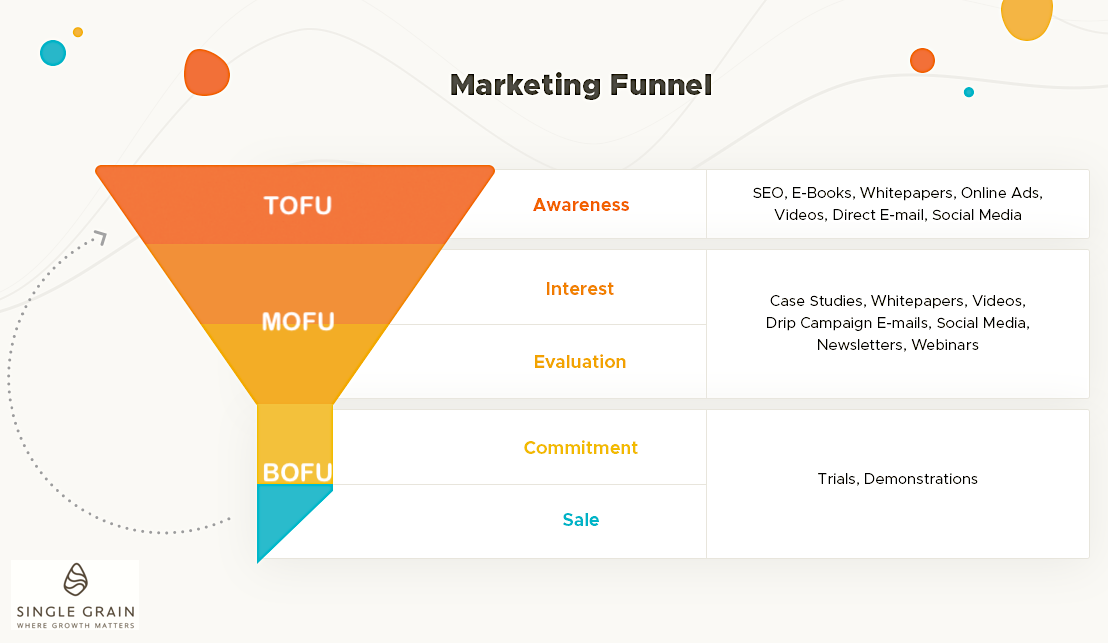
All teams must work together to produce the best results, which looks something like this:
- The marketing team aggregates data that’s related to the products that the customers are most interested in
- The SEO team works with that data to identify the most effective keywords
- The content team creates blog posts and web copy based on those keywords
Everything works in collaboration to deliver the best ROI.
Dive Deeper: How to Optimize Your Content Strategy with the Buyer’s Journey
2) Enhance Your Brand Presence Locally
Enterprise SEO teams local SEO. They have dedicated team members who work hard to improve the business’ presence in local markets. No large company is able to succeed if they aren’t able to penetrate the local markets. Hence, local SEO is the most important part of Enterprise SEO.
Dive Deeper: The Complete Guide to Local SEO
3) Improve Your Brand Image
Branded searches are common throughout the customer journey. People check reviews and read testimonials before engaging with a company.
Branded searches return a mix of results. Most of the results include properties that you control, such as your website and your social media profiles. But there are third-party review sites, Wikipedia pages and news articles that you don’t control.
These results (that you don’t control) are extremely valuable in shaping your brand image. So if you want to leave a positive impression of your brand on the mind of the searchers, you need to control your search results.
Enterprise SEO teams focus on generating positive reviews about your business, for reasons that have nothing to do with vanity – online reviews can increase your revenue by up to 40%:
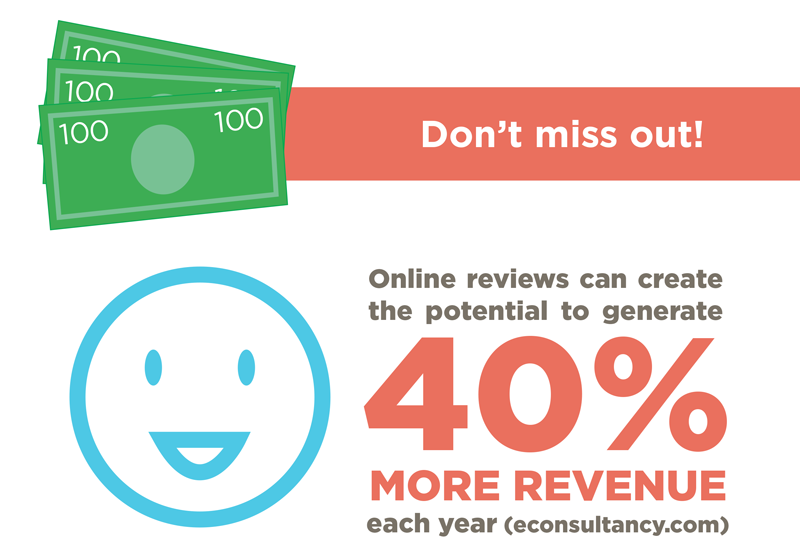
Reputable newspapers that cover your event and/or publish content related to your brand improve your brand reputation.
Additionally, when you publish tons of high-quality content, that indicates to Google that you are an expert in your industry and therefore you know what you’re talking about. As a result, your brand becomes a trusted and familiar resource for your target audience’s problems.
The more trust that people have in you, the higher the online reputation your brand has. This helps combat negative reviews and boost sales.
4) Prevent Your Website from Getting Hurt from Broad Core Algorithm Updates
Every time Google releases a broad core algorithm update, lots of websites get affected, some positively, some negatively.
With an enterprise SEO strategy in place, you’re more likely to benefit from the search algorithm updates.
Enterprise SEO focuses on improving the overall user experience and providing valuable content to the target audience. Google seems to prefer websites that offer the best possible UX to its customers.
Dive Deeper: What Is the Google BERT Search Algorithm Update?
5) Get Backlinks from High-Authority Websites
When big publications publish content related to your brand or a reputable newspaper covers your event, they’ll link to your website, thereby contributing to your backlink profile.
Besides, when you publish guides or tutorials that cover a topic in-depth, bloggers writing on similar topics are more likely to link to a post that explains the concept in detail instead of doing it themselves.
Dive Deeper:
* 9 Effective SEO Techniques to Drive Organic Traffic in 2023
* 5 Reasons How SEO Benefits Your SaaS Business (+ SaaS SEO Strategy)
* 7 Advanced SEO Hacks for Your To-Do List in 2023
4 Pillars of Enterprise SEO
The four things that make an enterprise SEO strategy a success are keyword selection, automation, SEO-optimized templates, and constant content creation. Let’s have a look at each one of them in-depth.
1) Quality Content Creation At Scale
Step one is creating quality content. Everything that comes next is a waste of time if you don’t get the foundations right.
Fundamentally, quality content in SEO means writing SEO-friendly copy. That means giving search engines updated, complete and accurate information with the correct level of depth. Doing so will significantly increase your chance of ranking at the top of the SERPs.
As you scale up content production though, it gets harder to maintain content quality. With more writers on the team, and more topics to cover, it’s no longer as straightforward to deliver consistently good content that ranks. You need solid systems and processes for onboarding, training and editing. Arguably the most important of all though, is providing excellent content briefs.
An excellent content brief directs writers as to what to include and how to optimize a post to rank in Google, including:
- Target keywords and synonyms of seed keywords
- Appropriate meta tags
- Compelling meta descriptions
- Improved readability score
- Increased keyword relevancy score
- Relevant internal links
Optimized content has a much better chance of ranking well in the SERPs, and higher rankings lead to more traffic and thus increased revenue.
So a content brief that lists these steps and key points will limit the chance of missing key elements or straying off-topic. Plus, it makes it easier and quicker to work with writers (especially new writers).
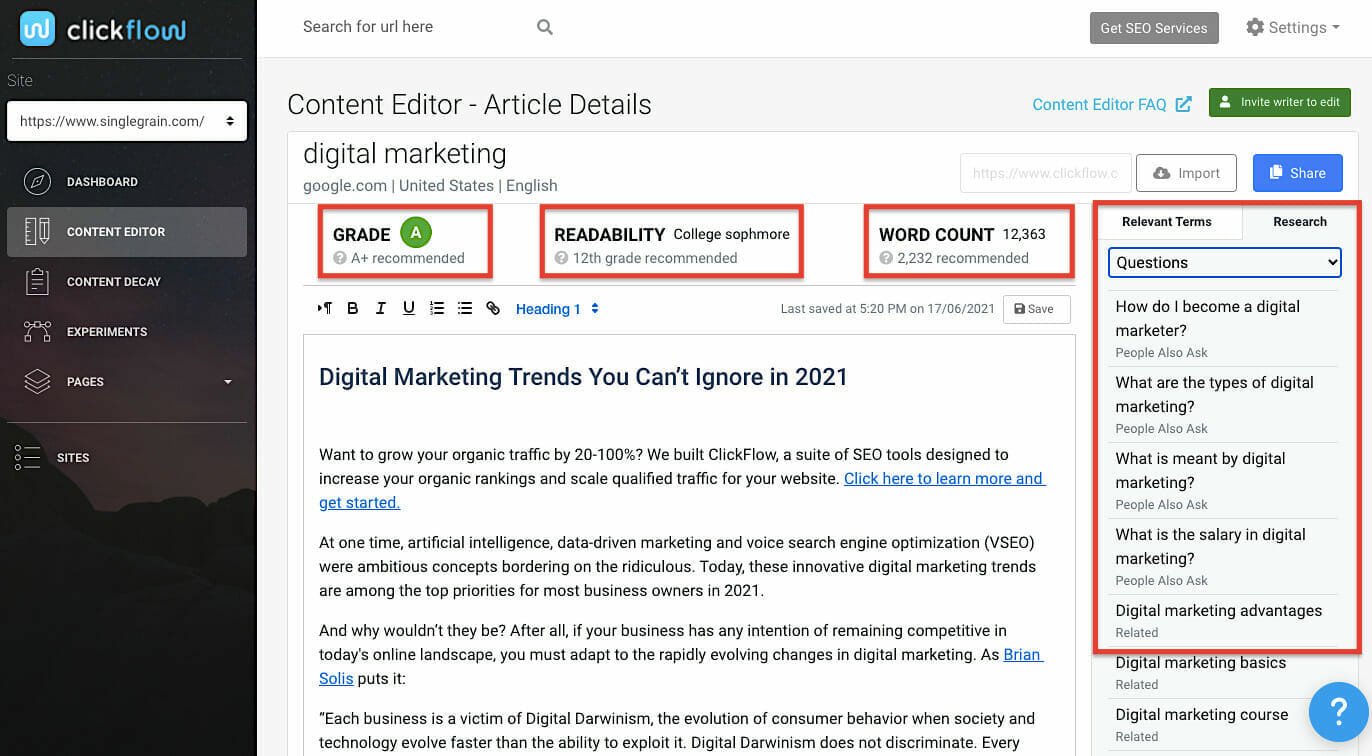
Without using content optimization software, there’s a lot of manual work to do to ensure your articles are properly optimized. It stacks up, and slows your content creation down a lot.
2) Keyword Selection
Let’s start with understanding search intent.
Google’s understanding of search terms has evolved dramatically. The search engine can now easily understand semantic relationships between words and phrases. And, thanks to Natural Language Processing (NLP), it can also interpret the intent behind a search.
This means that your emphasis should be on selecting keywords that are most relevant to the searchers’ intent.
For example, if you’re creating content for the awareness stage (that includes the problem your product solves), you shouldn’t include commercial keywords, such as “buy,” “download,” etc.
Here’s how your keyword selection should go at every stage of the customer’s journey.
Generic Keywords
At this stage, the top of the buyer’s journey or funnel, people aren’t sure what they actually want.
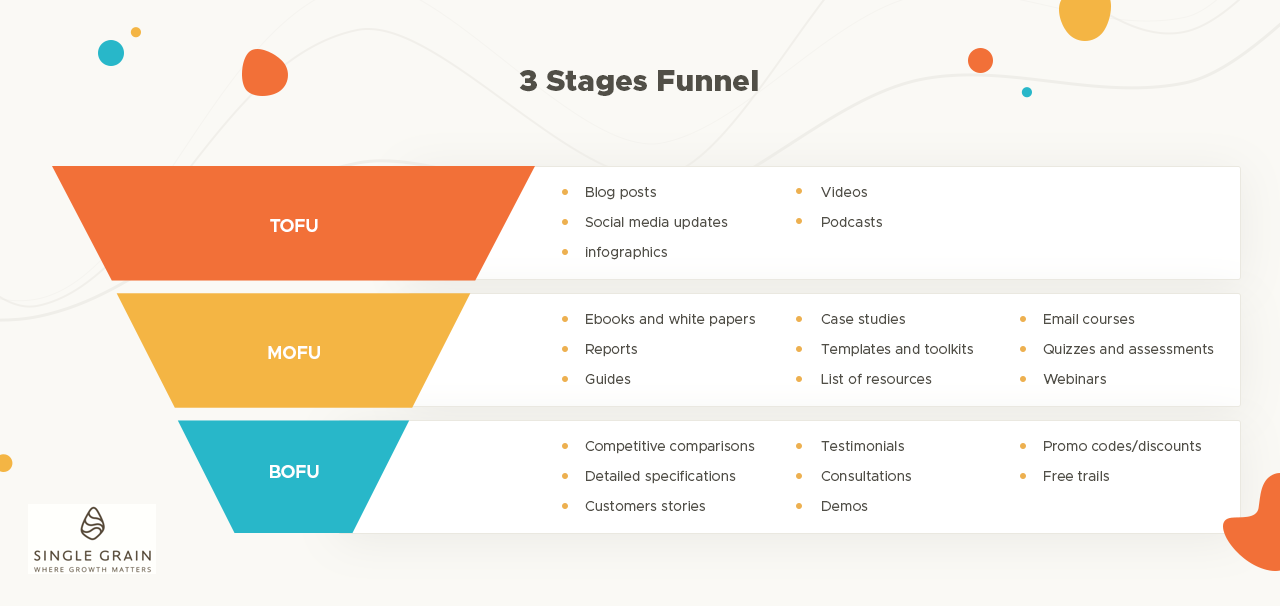
They are searching for the best solution for their problems through generic, non-branded queries. Appearing in front of your audience at this stage increases your chances of gaining the maximum visibility for your brand.
For example, if you are an e-commerce store owner then you should focus on generic keywords, such as shoes or shirts, to gain visibility for your brand in the TOFU or first stage of the buyer’s journey.
In this stage, create content that educates your target audience and addresses their queries.
In another example, when I searched Google with the keyword CRM, it returned only informational content:
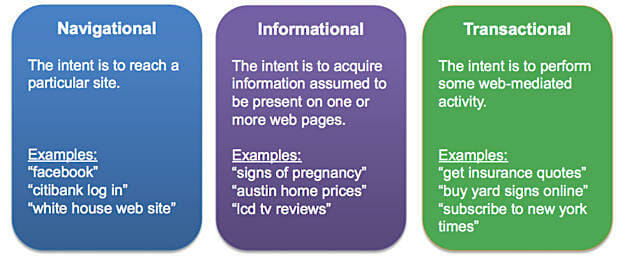
Hence, if you are trying to rank for a keyword such as CRM, you need to create educational content revolving around generic keywords. This will help you rank on the first page of Google.

Non-Branded Category Keywords
Non-branded keywords can help attract tons of organic traffic. These terms often have a high-volume of searches and represent individuals who are progressing down the sales funnel but are yet to decide on the brand from whom to purchase.
These terms are a little more specific than head keywords. Note: In SEO, there are two types of keywords: “head” keywords and “long-tail” keywords:

Some examples of non-branded category keywords are women’s shoes, CRM for startups, etc. This is the perfect time to interact with prospective buyers by dominating the search results at the category level.
At this stage, focus on medium-tail keywords and create content that educates your target audience about your products.
When I entered CRM for startups in Google, most of the results were of individual brands offering CRM:
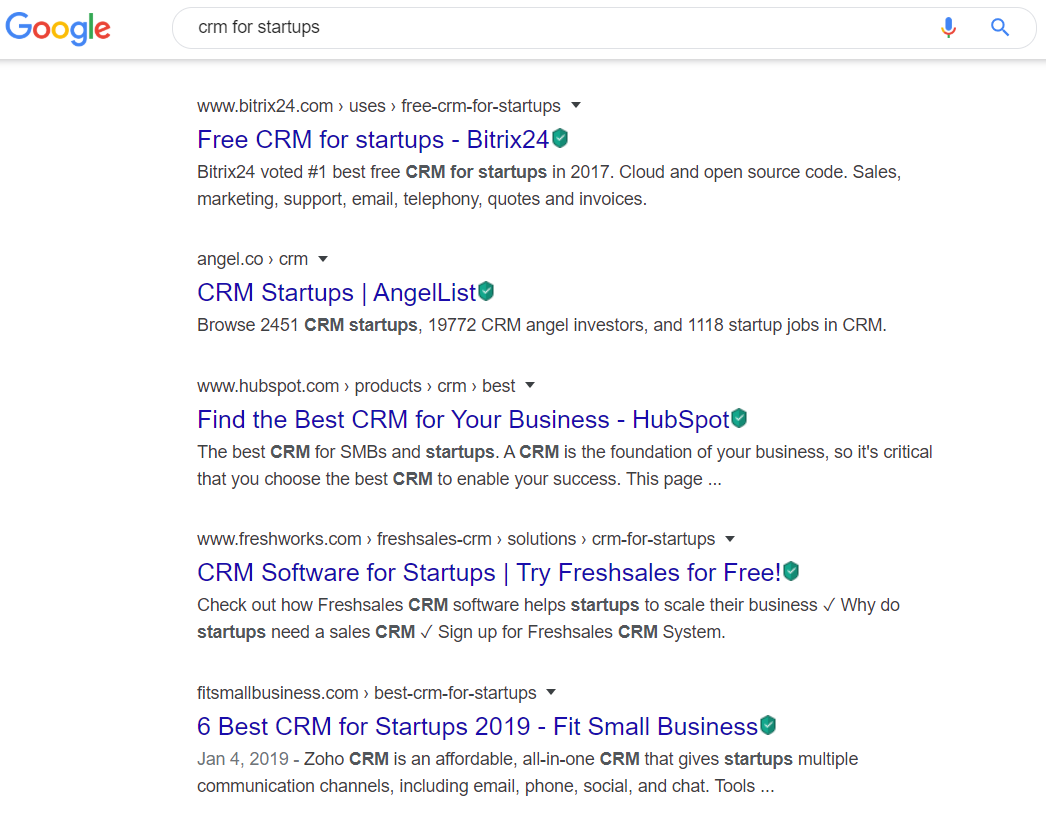
Branded Keywords
People using branded keywords know about your business and are probably looking for more information about your products.
The search results for branded terms include the properties controlled by you, like your website and social media profiles, as well as third-party content like reviews and Wikipedia pages.
With a well-executed enterprise SEO strategy, you increase the number of positive content about your brand in the search engines. This includes optimizing your existing web pages as well as publishing new posts around branded keywords that highlight your product features.
When I searched for Salesforce CRM, the first result was of the brand itself. However, there were also third-party review sites on the first page of the SERPs.
Notice the third result in the image below. The article presents positive information about the software that persuades people to subscribe to it.
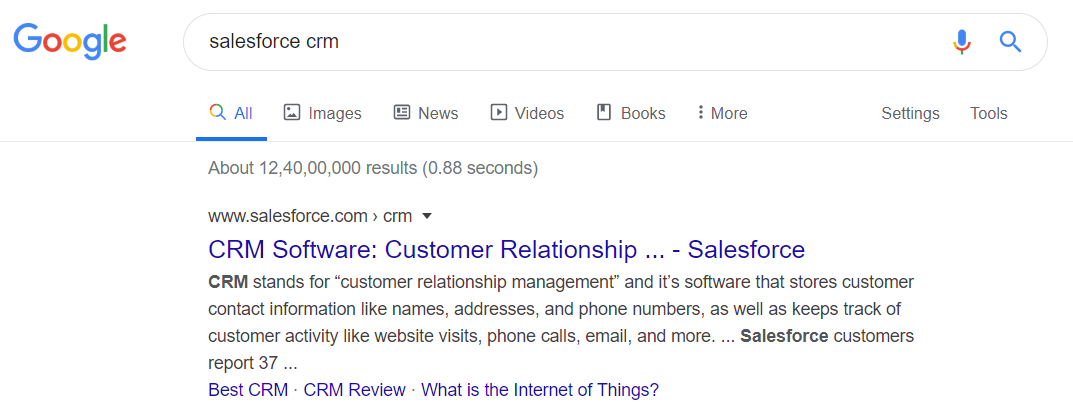
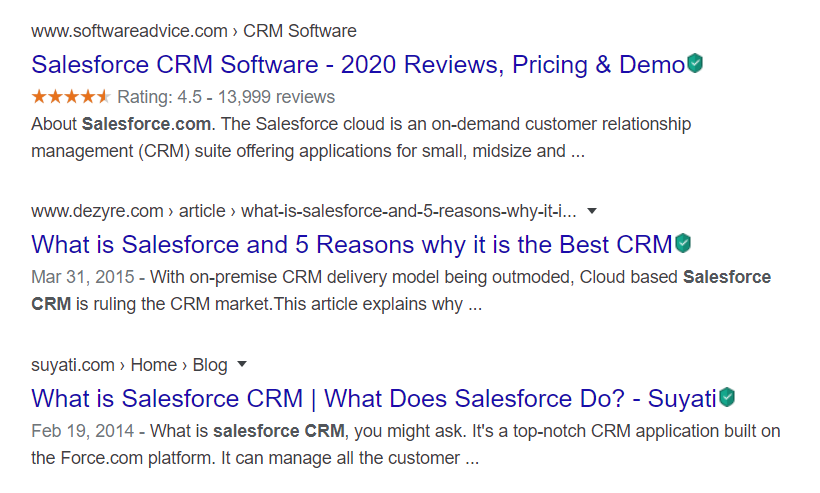
Remember, he higher the number of positive content you have for your business online, the greater will be your online reputation. Enterprise SEO ensures that there is enough positive material about your brand for branded searches.
Transactional Keywords
Transactional keywords are responsible for attracting people who are ready to convert. It usually includes long-tail keywords that are more specific than generic terms, such as CRM for startups under $100 or best running shoes for women.
I searched for buy running shoes for men. While most of the results had similar phrases, some of them also had LSI keywords.
Note: “Latent semantic indexing (LSI) is a system search engines use to analyze the other words people use surrounding a given topic. LSI keywords are words and phrases with a high degree of correlation to your target topic.”
Notice the first result in the image below. It doesn’t have the keyword “running shoes.” Instead, it contains the LSI keyword “sports shoes.”

That’s another benefit of enterprise SEO: It ensures that your website ranks for transactional keywords and their synonyms. This increases the chances of conversion even when the searcher is using a different keyword.
Dive Deeper:
* SEO Keyword Research Made Easy in 2023
* How to Use Google Keyword Planner for Content Creation
* Targeting Branded vs. SEO Keywords: Which Should You Focus On?
3) Automation
As discussed earlier, enterprise SEO is for websites with thousands of pages. Imagine receiving a spreadsheet with 5,000 products. Could you create content one by one for all these items? Even if you could, it would be very hectic and time-consuming.
That’s where automation comes into the picture. Marketing automation drives a 14.5% increase in sales productivity – and companies using automation enjoyed an average 12.2% reduction in marketing overheads:
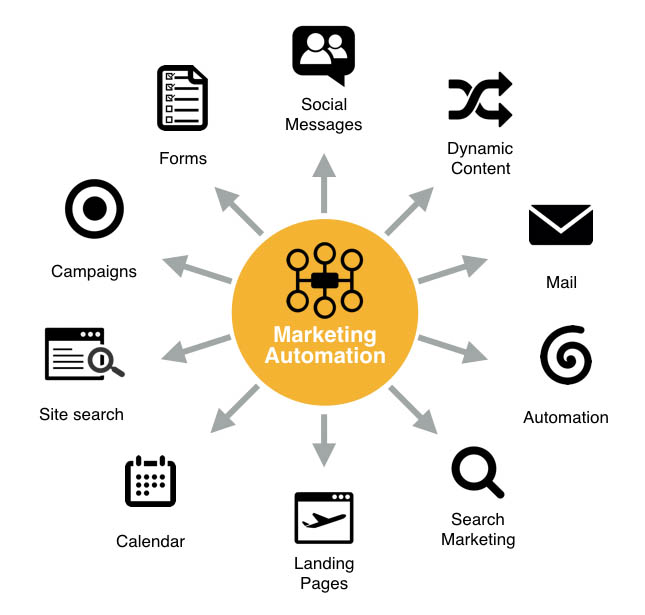
Automation saves a lot of time while focusing on important SEO tasks, such as:
- Keyword research
- Identifying problematic areas on your website
- Monitoring the quality of backlinks
- Analyzing title tags, meta descriptions, URLs, breadcrumb navigation links and canonical tags
Dive Deeper:
* What Is Marketing Automation: Definition, Benefits & Uses
* How to Use Google Keyword Planner for Content Creation
* 30 Ways to Come Up with Great Ideas for Your Blog Posts
4) Optimized Templates
Templates are the backbone of enterprise websites. When you have thousands of pages on your site, coding each one of them individually is next to impossible. That’s where templates come into the picture.
However, a lot of enterprise businesses do not take the advice of SEO experts before designing a website. This makes it harder for marketers to add or customize the content, which, in turn, causes problems in the ranking.
Therefore, it is crucial to get the help of SEO experts when designing or choosing a readymade template for your business website.
When designing or choosing a template for your business website, follow the best practices to ensure that they are SEO-friendly:
- Make sure all the templates are responsive.
- Make sure they’re built on well-written code that weighs less to significantly reduce the load on the server.
- Make sure they’re optimized for speed.
How to Do Enterprise SEO
Now that you know the benefits and the four pillars of enterprise SEO, let’s have a look at the steps to implement it in your business.
1) Improve Crawlability and User Experience
Crawling is the most important part of every SEO campaign. Crawling ensures that the pages on your site can be easily found by Google and other search engines. This is perhaps the first step in making your website rank.
Here are a few things that can help improve your site’s crawlability and user experience:
- Make it easy for your visitors to navigate through your website.
- Your home page shouldn’t be more than three clicks away, irrespective of how deep on your website the visitor is.
- Use 301 redirects when deleting old pages to ensure that your visitors don’t see error signs.
- Eliminate any technical issues that hamper the crawlability and quality of your websites, such as page speed, XML sitemaps and incorrect robots.txt.
- Add a search bar on your website along with an autocomplete option. This will make it easier for your site visitors to find products on your website.
While nobody can predict what Google will do next, one thing will remain constant: The search engine will focus on giving people what they want, when they want it. Hence, a forward-thinking strategy would be to focus on providing the best possible user experience.
2) Target ‘Striking Distance’ Keywords
Striking distance keywords are the terms for which your website ranks in positions 11-20. These are the low-hanging fruits that can provide you with some quick wins. Moving the keywords that are close to the first page to page one offers a good chance to capitalize on conversions.
Begin by compiling a list of pages that rank on the second page of Google results. One method is to use the Search Console data to identify the low-hanging fruits and manually check them on Google to find the latest rankings. As enterprise businesses have more than one country to target, you might need to use a VPN to check the rankings accurately.
Tools like SEOmonitor can make it easier for you to find those pages. Set up a campaign on SEOmonitor and the tool will automatically start checking the rankings of your website.
All you need to do is apply an advanced filter and change the rank to greater than 10 and less than 21. You can also set a minimum threshold for the monthly search volume and add a filter on the SEO difficulty. This will help you narrow down the results and find easy wins quickly.

Once you have prepared your list of striking-distance keywords, the next step is to analyze the pages ranking for those keywords. Check critical-ranking factors such as page speed, Alt text tag, and backlinks.
As a part of your SEO audit, you should also look at sites that rank on page one to figure out what they have that you don’t. Are there charts and images on their content that makes it easier for the reader to consume the content? Do they answer additional related user queries?
A few things that you can improve on these pages include:
- Title tag
- Keyword targeting
- Meta description
- New keyword insertion
- Readability
- Backlinks (both internal and external)
You can also add more text to the content and update the stats (if any) as per the latest research.
By targeting striking-distance keywords, you can continuously update and improve your website’s visibility in search engines, as well as your ROI.
3) Optimize for Voice and Visual Search
Voice and visual searches provide a great opportunity for enterprise SEOs to reach a wider audience and boost their online presence.
30% of all browsing sessions will include a voice search by 2020.
Gartner predicts that by 2021 early adopter brands that redesign their website to support voice and visual search will increase digital commerce revenue by 30%.
To make voice search a part of your enterprise SEO strategy, begin with optimizing existing content for screenless searches.
Since enterprise websites have thousands of pages, optimizing each one of them would take months, if not years. Therefore, focus on the content that ranks in position zero (featured snippets) or that has the opportunity to rank there. Why? Because:
60% of voice search results come from featured snippets.
Once you’ve decided on which pages to optimize for voice search, follow these tips:
- Analyze your competitors’ answers to different featured snippets to give you a fair idea of what Google prefers.
- A study by Backlinko found that Google tends to answer voice search queries with short, 29-word results.
- Include direct answers for multiple similar questions in a single post.
- Ensure that your answers are written at a ninth-grade reading level.
- Use numbered or bulleted lists in how-to guides.
These optimizations will increase your chances of acquiring featured snippets and voice search results, which will lead to increased traffic and conversions.
Moreover, visual search turns a smartphone into a discovery engine by using an image as the stimulus to provide related results. In other words, users don’t need to describe what they’re looking for through text.

With the rise in popularity of Google Lens, optimizing for visual search has become important, especially for enterprise e-commerce brands who want to dominate the market.
Here are a few steps to make visual search a part of your enterprise SEO strategy:
- Focus on the basics: Upload image XML sitemaps, check the indexation status of images, and update the product inventory.
- Conduct in-depth research: Try to understand what your target audience is looking to do when conducting visual searches. Are they looking for ideas? Are they looking for information related to the image? This will help you create content that they’re looking for.
- Optimize images: While all the images on your website should be optimized using image SEO best practices, you need to go the extra mile for visual search. Eliminate clutter from images and maintain a consistent aesthetic that is unique to your brand. This makes it easier for search engines to understand who you are and which products/services you are promoting.
Dive Deeper:
* VSEO: How Voice Search and Conversational AI Are Changing SEO
* 106 Quick and Fascinating Voice Search Statistics [infographic]
* Beginner’s Guide to Voice Search SEO
4) Focus on Enterprise-Level Link Building
Link building has a huge impact on a website’s ranking.
Ahrefs found a direct correlation between a page’s monthly organic search traffic and their backlinks from unique websites: The more backlinks a page has, the more organic traffic it gets from Google.
As you can see in the graph below, with the rise in the number of referring domains, organic search traffic also increases:

As a business enterprise company, you might already have plenty of high-quality links from trusted sites in your industry. But that doesn’t mean you should stop focusing on acquiring backlinks.
To broaden your backlink profile, begin with analyzing unlinked mentions. These are online mentions of your brand, products or services that do not link back to your website. This can help you acquire hundreds of backlinks quickly.
Here’s how: The author of the article mentioned you, so this means they’re already familiar with your brand. All you need to do is reach out and convince them to convert the mention into a link.
Tools like Ahrefs can help you find unlinked mentions easily:
- Search for your brand name and exclude results from your domain.
- Then use the “Highlight unlinked mentions” filter and add your website’s URL. This will highlight pages that have mentioned your business but haven’t linked to you.
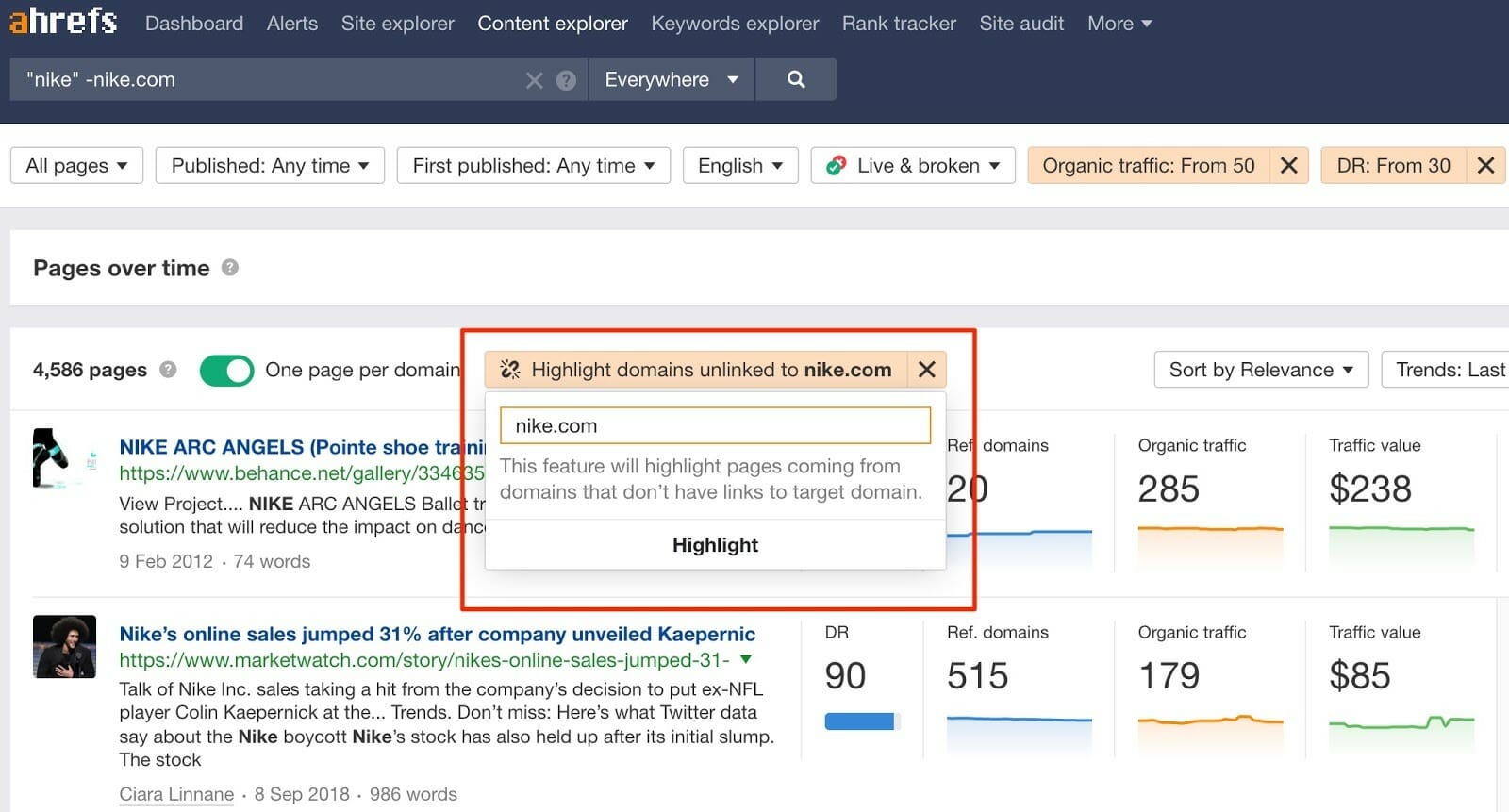
Another way to acquire backlinks is cold outreach. Look for people who have written about the topics related to your industry. Since they’ve written about those topics before, they may be interested in reading your articles. And if they find your content interesting, they might even link to it.
To figure out who to reach out to:
- Enter the topic of your article in Google and check out the websites that appear on the first page of the SERPs.
- Find the email addresses of the website owners by using tools like Hunter and Snovio.
- Start a link acquisition campaign by outreaching them.
- Send an email with a compelling reason on why they should read or link to your post.
The below image is an example of a well-written link acquisition email. It starts with the introduction of the author of the article. The sender then asks if Convince & Convert (the receiver) is accepting guest posts and includes a single line description of what the receiver can expect in the article. This increases the chances of responding, as the receiver now knows what’s there in the article. Finally, it ends with a sweet gesture.

Tip: Everyone looks for their benefit. Highlight what’s in it for them.
Dive Deeper:
* The Ultimate Guide to Link Building with Content for SEO
* How – And Why – To Build A Backlink Portfolio
* A 3-Step Strategy to Build Links and Drive Referral Traffic to Your SaaS Website
5) Don’t Ignore Internal Linking
While most SEOs focus on external linking, a lot of them forget about the power of internal linking.
At the most basic level, internal linking makes it easier for search engine crawlers to find new pages and rank them appropriately.
Another advantage of internal linking is that it gives your site visitors more reasons to stay for longer, thereby increasing dwell time. This, in turn, boosts your ranking in the SERPs.
Internal linking is an easy task for smaller websites, but it can be problematic for enterprise sites with lots of content. Therefore, it is best to use a related posts widget to show similar web pages from your website at the end of the blog:

You can also easily add internal links within the body of the content where relevant:
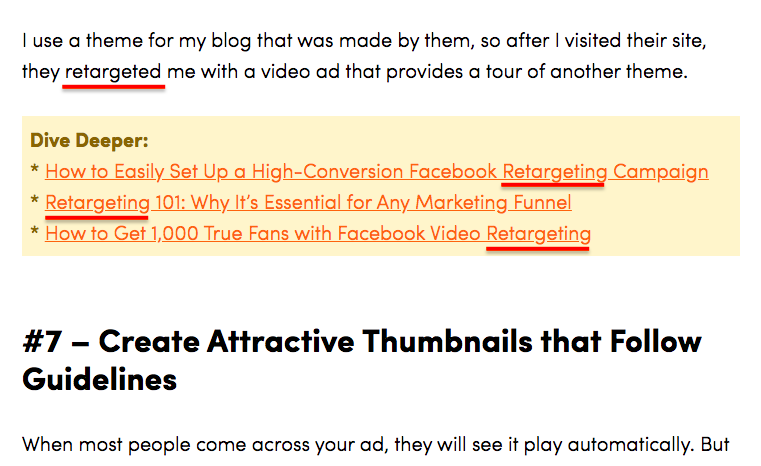
Further, you should implement a policy that every new post should feature three to five internal links from relevant pages. This will help you streamline your linking strategy.
Enterprise SEO Examples
Now that you have an understanding of enterprise SEO strategies, let’s have a look at some of the big brands that have implemented enterprise SEO campaigns and saw some great results.
1) Salesforce
Salesforce, the world’s leading CRM platform, has a whopping 58,900 pages in its website, so optimizing all the pages manually isn’t feasible.
Websites like these usually run on content management systems that allow bulk management of pages. The company started with strategic onsite auditing to find and eliminate technical errors in the website. Then they focused on earning links from relevant websites.
As a result, the company ranks for around 81,417 keywords on the first page of Google and they increased their traffic by around one million in a year:

2) Adobe
Adobe, an American multinational computer software company, has 94,300 pages on their website. Manually optimizing all these pages would take years to complete, which is why the company uses a number of enterprise SEO strategies to improve its search performance.
They created separate landing pages for each of their features, and within a year the company saw an increase in incoming organic traffic from 6.3 million to 9 million. Adobe now ranks for 197,467 keywords on page one of Google, up from 190,120 in March 2019:
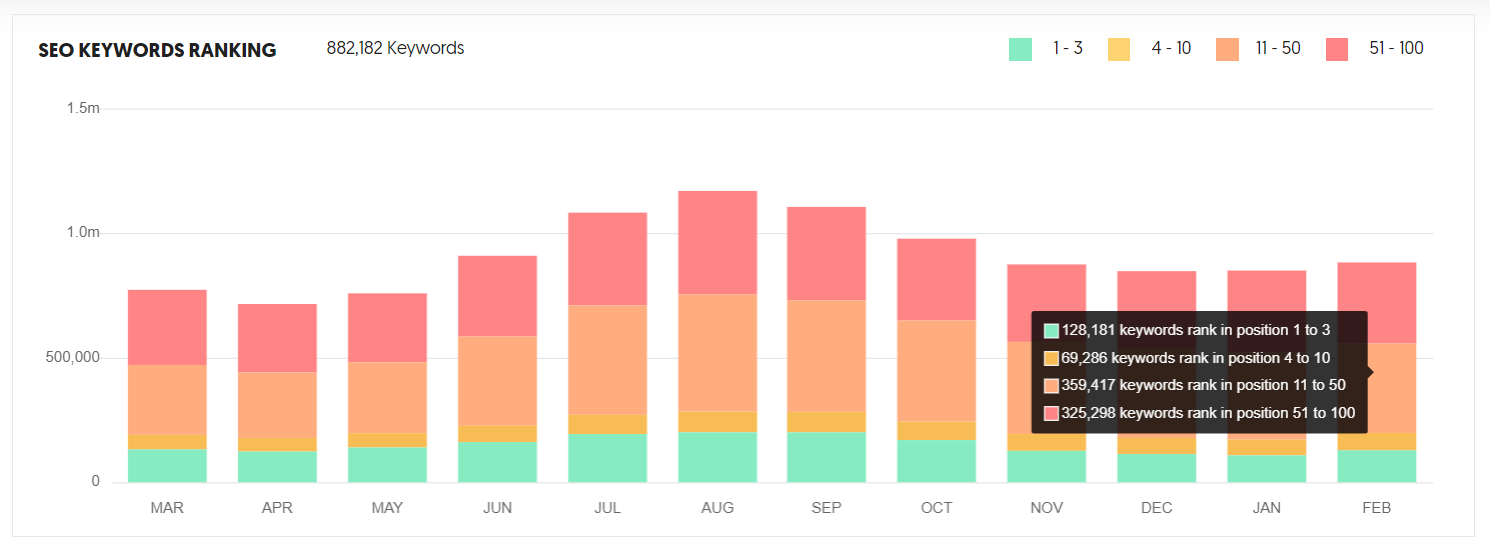
3) MailChimp
MailChimp, a marketing automation platform and email marketing service, has 154,000 pages on its website. Though MailChimp has become popular, they still prioritize SEO to stay ahead of their competitors.
They published five long-form articles every month for over a year, and as a result, their website now ranks for 60,385 keywords on page one of Google.
The company has acquired over 23,330,955 backlinks from 348,672 referring domains since its launch. They also saw an increase in organic search traffic from 1.1 million to 1.4 million in a year:

4) Square
Square, a financial services company, has around 465,000 web pages. A website with this many pages needs a well-planned enterprise SEO strategy to improve its search results performance.
They focused heavily on internal linking. Additionally, they worked on improving their site experience so users stay for longer on their website, thereby boosting the dwell time and reducing bounce rate.
As a result, they saw a rise in organic traffic from 1.6 million to 2.5 million in twelve months. They now rank for 112,660 keywords on page one of Google:

Enterprise SEO Tools
Enterprise SEO tools can improve your efficiency and make it easier for you to manage websites with millions of pages and keywords.
Here are the three most powerful enterprise SEO tools to help you get the job done.
1) seoClarity
seoClarity is an all-in-one SEO software that provides actionable insights for your organic search and content performance using machine learning. It enables you to perform site audits and deep crawls to detect technical SEO errors and duplicate content.
For enterprises based on multiple locations, seoClarity offers a Local Clarity function that allows you to leverage local keywords. The Link Clarity feature shows you which of your pages need inbound links the most so you can work on it to improve its rankings.
Its “actionable insights” algorithm is designed to learn from thousands of data points and then generate insights to scale SEO across the enterprise.
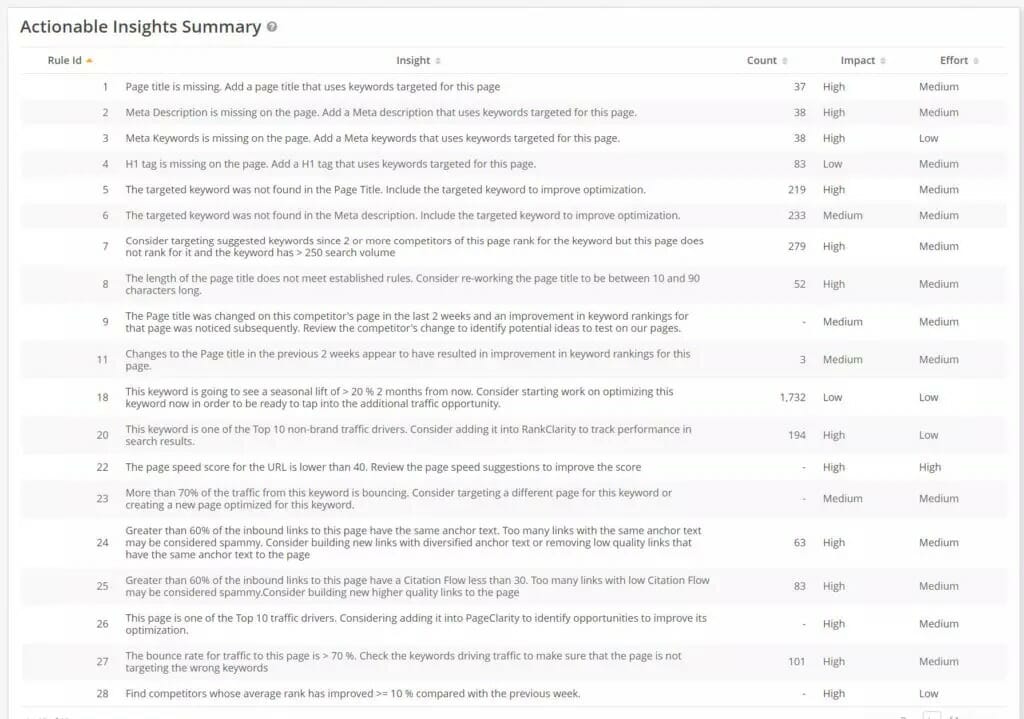
2) BrightEdge
What makes BrightEdge stand out from the rest of the tools is that it offers a unique metric called “Share of Voice”. This is a measure of your overall visibility in search engines.
You can perform keyword research, competitive analysis, technical SEO audit, content optimization and creation, backlink research, keyword tracking, and reporting, all from one platform.
It provides real-time insights into your ranks, search volume, page speed performance, and it offers recommendations to boost the position in the SERPs:

3) Conductor
Conductor provides insight into what your target audience is searching for in real-time and delivers recommended actions that you should be taking to boost visibility in search engines.
It analyzes your website to highlight content performance, keyword alerts, competitive insights, and optimization opportunities across multiple countries:

It also provides an in-depth web crawl report, so you know if all your pages are within reach for search engine crawlers. You can evaluate both internal and external links to improve your linking structure.
Dive Deeper: LinkedIn Ads for Enterprise B2B SaaS: The Only Guide You’ll Need
Final Thoughts on Enterprise SEO
Enterprise SEO is all about using a strategic approach with large companies to rank higher in the search results. It is scalable and includes advanced tactics meant for websites with thousands of pages. Doing SEO for enterprise websites is not an easy task.
It involves analyzing and optimizing thousands of pages, if not millions. Begin with improving crawlability and user experience and then focus on easy wins (by targeting striking distance keywords). Optimizing for voice and visual search can help you prepare for the future. Last but not least, use enterprise SEO platforms to improve the efficiency and productivity of your work.



